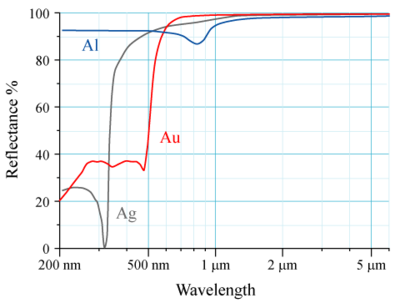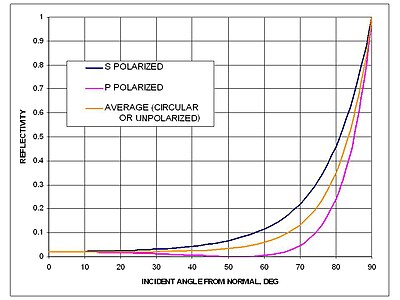
The reflectance of the surface of a material is its effectiveness in reflecting radiant energy. It is the fraction of incident electromagnetic power that is reflected at the boundary. Reflectance is a component of the response of the electronic structure of the material to the electromagnetic field of light, and is in general a function of the frequency, or wavelength, of the light, its polarization, and the angle of incidence. The dependence of reflectance on the wavelength is called a reflectance spectrum or spectral reflectance curve.
Mathematical definitions
Hemispherical reflectance
The hemispherical reflectance of a surface, denoted R, is defined as where Φe is the radiant flux reflected by that surface and Φe is the radiant flux received by that surface.
Spectral hemispherical reflectance
The spectral hemispherical reflectance in frequency and spectral hemispherical reflectance in wavelength of a surface, denoted Rν and Rλ respectively, are defined as where
- Φe,ν is the spectral radiant flux in frequency reflected by that surface;
- Φe,ν is the spectral radiant flux in frequency received by that surface;
- Φe,λ is the spectral radiant flux in wavelength reflected by that surface;
- Φe,λ is the spectral radiant flux in wavelength received by that surface.
Directional reflectance
The directional reflectance of a surface, denoted RΩ, is defined as where
- Le,Ω is the radiance reflected by that surface;
- Le,Ω is the radiance received by that surface.
This depends on both the reflected direction and the incoming direction. In other words, it has a value for every combination of incoming and outgoing directions. It is related to the bidirectional reflectance distribution function and its upper limit is 1. Another measure of reflectance, depending only on the outgoing direction, is I/F, where I is the radiance reflected in a given direction and F is the incoming radiance averaged over all directions, in other words, the total flux of radiation hitting the surface per unit area, divided by π. This can be greater than 1 for a glossy surface illuminated by a source such as the sun, with the reflectance measured in the direction of maximum radiance (see also Seeliger effect).
Spectral directional reflectance
The spectral directional reflectance in frequency and spectral directional reflectance in wavelength of a surface, denoted RΩ,ν and RΩ,λ respectively, are defined as where
- Le,Ω,ν is the spectral radiance in frequency reflected by that surface;
- Le,Ω,ν is the spectral radiance received by that surface;
- Le,Ω,λ is the spectral radiance in wavelength reflected by that surface;
- Le,Ω,λ is the spectral radiance in wavelength received by that surface.
Again, one can also define a value of I/F (see above) for a given wavelength.
Reflectivity

For homogeneous and semi-infinite (see halfspace) materials, reflectivity is the same as reflectance. Reflectivity is the square of the magnitude of the Fresnel reflection coefficient, which is the ratio of the reflected to incident electric field; as such the reflection coefficient can be expressed as a complex number as determined by the Fresnel equations for a single layer, whereas the reflectance is always a positive real number.
For layered and finite media, according to the CIE, reflectivity is distinguished from reflectance by the fact that reflectivity is a value that applies to thick reflecting objects. When reflection occurs from thin layers of material, internal reflection effects can cause the reflectance to vary with surface thickness. Reflectivity is the limit value of reflectance as the sample becomes thick; it is the intrinsic reflectance of the surface, hence irrespective of other parameters such as the reflectance of the rear surface. Another way to interpret this is that the reflectance is the fraction of electromagnetic power reflected from a specific sample, while reflectivity is a property of the material itself, which would be measured on a perfect machine if the material filled half of all space.
Surface type
Given that reflectance is a directional property, most surfaces can be divided into those that give specular reflection and those that give diffuse reflection.
For specular surfaces, such as glass or polished metal, reflectance is nearly zero at all angles except at the appropriate reflected angle; that is the same angle with respect to the surface normal in the plane of incidence, but on the opposing side. When the radiation is incident normal to the surface, it is reflected back into the same direction.
For diffuse surfaces, such as matte white paint, reflectance is uniform; radiation is reflected in all angles equally or near-equally. Such surfaces are said to be Lambertian.
Most practical objects exhibit a combination of diffuse and specular reflective properties.
Water reflectance

Reflection occurs when light moves from a medium with one index of refraction into a second medium with a different index of refraction.
Specular reflection from a body of water is calculated by the Fresnel equations. Fresnel reflection is directional and therefore does not contribute significantly to albedo which primarily diffuses reflection.
A real water surface may be wavy. Reflectance, which assumes a flat surface as given by the Fresnel equations, can be adjusted to account for waviness.
Grating efficiency
The generalization of reflectance to a diffraction grating, which disperses light by wavelength, is called diffraction efficiency.
Other radiometric coefficients
| Quantity | SI units | Notes | |
|---|---|---|---|
| Name | Sym. | ||
| Hemispherical emissivity | ε | — | Radiant exitance of a surface, divided by that of a black body at the same temperature as that surface. |
| Spectral hemispherical emissivity | εν ελ |
— | Spectral exitance of a surface, divided by that of a black body at the same temperature as that surface. |
| Directional emissivity | εΩ | — | Radiance emitted by a surface, divided by that emitted by a black body at the same temperature as that surface. |
| Spectral directional emissivity | εΩ,ν εΩ,λ |
— | Spectral radiance emitted by a surface, divided by that of a black body at the same temperature as that surface. |
| Hemispherical absorptance | A | — | Radiant flux absorbed by a surface, divided by that received by that surface. This should not be confused with "absorbance". |
| Spectral hemispherical absorptance | Aν Aλ |
— | Spectral flux absorbed by a surface, divided by that received by that surface. This should not be confused with "spectral absorbance". |
| Directional absorptance | AΩ | — | Radiance absorbed by a surface, divided by the radiance incident onto that surface. This should not be confused with "absorbance". |
| Spectral directional absorptance | AΩ,ν AΩ,λ |
— | Spectral radiance absorbed by a surface, divided by the spectral radiance incident onto that surface. This should not be confused with "spectral absorbance". |
| Hemispherical reflectance | R | — | Radiant flux reflected by a surface, divided by that received by that surface. |
| Spectral hemispherical reflectance | Rν Rλ |
— | Spectral flux reflected by a surface, divided by that received by that surface. |
| Directional reflectance | RΩ | — | Radiance reflected by a surface, divided by that received by that surface. |
| Spectral directional reflectance | RΩ,ν RΩ,λ |
— | Spectral radiance reflected by a surface, divided by that received by that surface. |
| Hemispherical transmittance | T | — | Radiant flux transmitted by a surface, divided by that received by that surface. |
| Spectral hemispherical transmittance | Tν Tλ |
— | Spectral flux transmitted by a surface, divided by that received by that surface. |
| Directional transmittance | TΩ | — | Radiance transmitted by a surface, divided by that received by that surface. |
| Spectral directional transmittance | TΩ,ν TΩ,λ |
— | Spectral radiance transmitted by a surface, divided by that received by that surface. |
| Hemispherical attenuation coefficient | μ | m | Radiant flux absorbed and scattered by a volume per unit length, divided by that received by that volume. |
| Spectral hemispherical attenuation coefficient | μν μλ |
m | Spectral radiant flux absorbed and scattered by a volume per unit length, divided by that received by that volume. |
| Directional attenuation coefficient | μΩ | m | Radiance absorbed and scattered by a volume per unit length, divided by that received by that volume. |
| Spectral directional attenuation coefficient | μΩ,ν μΩ,λ |
m | Spectral radiance absorbed and scattered by a volume per unit length, divided by that received by that volume. |
See also
- Bidirectional reflectance distribution function
- Colorimetry
- Emissivity
- Lambert's cosine law
- Transmittance
- Sun path
- Light Reflectance Value
- Albedo
- Reststrahlen effect
- Lyddane–Sachs–Teller relation
References
- ^ "Thermal insulation — Heat transfer by radiation — Physical quantities and definitions". ISO 9288:1989. ISO catalogue. 1989. Retrieved 2015-03-15.
- Cuzzi, Jeffrey; Chambers, Lindsey; Hendrix, Amanda (Oct 21, 2016). "Rough Surfaces: is the dark stuff just shadow?". Icarus. 289: 281–294. doi:10.1016/j.icarus.2016.10.018. PMC 6839776. PMID 31708591.
- See for example P.G.J Irwin; et al. (Jan 12, 2022). "Hazy Blue Worlds: A Holistic Aerosol Model for Uranus and Neptune, Including Dark Spots". Journal of Geophysical Research: Planets. 127 (6): e2022JE007189. arXiv:2201.04516. Bibcode:2022JGRE..12707189I. doi:10.1029/2022JE007189. hdl:1983/65ee78f0-1d28-4017-bbd9-1b49b24700d7. PMC 9286428. PMID 35865671. S2CID 245877540.
- E. Hecht (2001). Optics (4th ed.). Pearson Education. ISBN 0-8053-8566-5.
- IUPAC, Compendium of Chemical Terminology, 2nd ed. (the "Gold Book") (1997). Online corrected version: (2006–) "Reflectance". doi:10.1351/goldbook.R05235
- "CIE International Lighting Vocabulary". Archived from the original on 2016-06-16. Retrieved 2010-12-04.
- Palmer and Grant, The Art of Radiometry
- Ottaviani, M. and Stamnes, K. and Koskulics, J. and Eide, H. and Long, S.R. and Su, W. and Wiscombe, W., 2008: 'Light Reflection from Water Waves: Suitable Setup for a Polarimetric Investigation under Controlled Laboratory Conditions. Journal of Atmospheric and Oceanic Technology, 25 (5), 715--728.
External links
- Reflectivity of metals Archived 2016-03-04 at the Wayback Machine.
- Reflectance Data.
 where Φe is the
where Φe is the 
 where
where
 where
where

 where
where